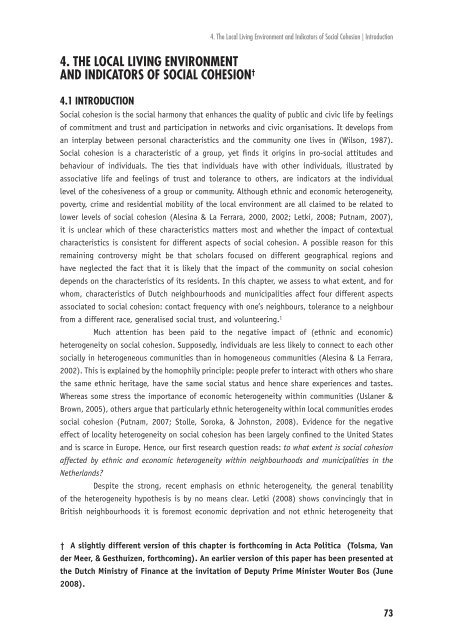Ethnic Hostility among Ethnic Majority and Minority Groups
Ethnic Hostility among Ethnic Majority and Minority Groups
Ethnic Hostility among Ethnic Majority and Minority Groups
You also want an ePaper? Increase the reach of your titles
YUMPU automatically turns print PDFs into web optimized ePapers that Google loves.
4. THE LOCAL LIVING ENVIRONMENT<br />
AND INDICATORS OF SOCIAL COHESION †<br />
4. The Local Living Environment <strong>and</strong> Indicators of Social Cohesion | Introduction<br />
4.1 INTRODUCTION<br />
Social cohesion is the social harmony that enhances the quality of public <strong>and</strong> civic life by feelings<br />
of commitment <strong>and</strong> trust <strong>and</strong> participation in networks <strong>and</strong> civic organisations. It develops from<br />
an interplay between personal characteristics <strong>and</strong> the community one lives in (Wilson, 1987).<br />
Social cohesion is a characteristic of a group, yet fi nds it origins in pro-social attitudes <strong>and</strong><br />
behaviour of individuals. The ties that individuals have with other individuals, illustrated by<br />
associative life <strong>and</strong> feelings of trust <strong>and</strong> tolerance to others, are indicators at the individual<br />
level of the cohesiveness of a group or community. Although ethnic <strong>and</strong> economic heterogeneity,<br />
poverty, crime <strong>and</strong> residential mobility of the local environment are all claimed to be related to<br />
lower levels of social cohesion (Alesina & La Ferrara, 2000, 2002; Letki, 2008; Putnam, 2007),<br />
it is unclear which of these characteristics matters most <strong>and</strong> whether the impact of contextual<br />
characteristics is consistent for different aspects of social cohesion. A possible reason for this<br />
remaining controversy might be that scholars focused on different geographical regions <strong>and</strong><br />
have neglected the fact that it is likely that the impact of the community on social cohesion<br />
depends on the characteristics of its residents. In this chapter, we assess to what extent, <strong>and</strong> for<br />
whom, characteristics of Dutch neighbourhoods <strong>and</strong> municipalities affect four different aspects<br />
associated to social cohesion: contact frequency with one’s neighbours, tolerance to a neighbour<br />
from a different race, generalised social trust, <strong>and</strong> volunteering. 1<br />
Much attention has been paid to the negative impact of (ethnic <strong>and</strong> economic)<br />
heterogeneity on social cohesion. Supposedly, individuals are less likely to connect to each other<br />
socially in heterogeneous communities than in homogeneous communities (Alesina & La Ferrara,<br />
2002). This is explained by the homophily principle: people prefer to interact with others who share<br />
the same ethnic heritage, have the same social status <strong>and</strong> hence share experiences <strong>and</strong> tastes.<br />
Whereas some stress the importance of economic heterogeneity within communities (Uslaner &<br />
Brown, 2005), others argue that particularly ethnic heterogeneity within local communities erodes<br />
social cohesion (Putnam, 2007; Stolle, Soroka, & Johnston, 2008). Evidence for the negative<br />
effect of locality heterogeneity on social cohesion has been largely confi ned to the United States<br />
<strong>and</strong> is scarce in Europe. Hence, our fi rst research question reads: to what extent is social cohesion<br />
affected by ethnic <strong>and</strong> economic heterogeneity within neighbourhoods <strong>and</strong> municipalities in the<br />
Netherl<strong>and</strong>s?<br />
Despite the strong, recent emphasis on ethnic heterogeneity, the general tenability<br />
of the heterogeneity hypothesis is by no means clear. Letki (2008) shows convincingly that in<br />
British neighbourhoods it is foremost economic deprivation <strong>and</strong> not ethnic heterogeneity that<br />
† A slightly different version of this chapter is forthcoming in Acta Politica (Tolsma, Van<br />
der Meer, & Gesthuizen, forthcoming). An earlier version of this paper has been presented at<br />
the Dutch Ministry of Finance at the invitation of Deputy Prime Minister Wouter Bos (June<br />
2008).<br />
73












